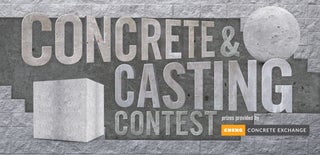Introduction: A Simple Modern Bench
My goal for this project was to create a simple, modern, wooden bench with a concrete top and storage underneath. I had limited space (about 4 feet by 16 inches) to work with so I made my bench fit closely to those dimensions. Also I wanted the bench to be built on the cheap and ideally out of reclaimed wood so I used only 2x4's and 4x4's for the base. The color of stain, concrete, and metal bars can all be customized so I listed them as optional.
Materials:
4"x4"x96" - 1
2"x4"x96" - 2
3/4"x120" Black Pipe- 2
80 lb Bag of Concrete - 1
Various Scrap Boards, Plywood/Melamine Panel - (This is for the concrete mold which I will discuss later)
Concrete Dye (Optional)
Portland Cement (Optional)
Concrete Sealer (Optional)
Stain (Optional)
Spray Paint (Optional)
Tools:
Saws (I used a miter and jigsaw)
Router (Optional)
Power Drill (with various bits)
1" Forstner Bit
Pocket Hole Jig (Optional)
Angle Grinder or Heavy Wire Snips
Pipe Cutter
Sander/Sand Paper
Step 1: Cutting the Pieces
I used a miter saw to cut the pieces to these quantities and dimensions:
2"x4"x39" - 4
2"x4"x7" - 4
4"x4"x18" - 4
The concrete bench seat will be 4 feet wide, 16 inches deep and 1.5 inches high so I designed the wooden base to accommodate a 1 inch lip all around the sides making the completed base dimensions 46"x14"x18".
Step 2: Drilling the Pocket Holes
I chose pocket holes so I wouldn't see screws on the outside which lends a more modern and sleek look to the bench. I drilled pocket holes into the 2x4x39's and 2x4x7's on the ends as pictured. The easiest method was to use a pocket hole jig. A store bought one is a good investment but it's not hard to create your own jig from a spare piece of wood.
Step 3: Cutting Out the Pipe Sockets
To create sockets for the pipe shelves to fit I used a Forstner Bit to cut three circular cavities from two of the 2x4x7's. I then used a router to remove the wood from one side of the circular holes on one of the 2x4x7's so the pipes could slide down and into position, making them removable It was also an option to just leave the circular cavities as is and not route one side but once the bench was finished the pipes would not be removable without taking apart the bench. If say I wanted to put the bench outside and the pipes needed repainting after a season or two, this would be a big hassle.
Step 4: Building the Frame
The frame of the bench is pretty simple. I attached the legs to the 2x4x39's by applying glue and then screws in the pocket holes. I used the same technique for the 2x4x7's, clamping them also for good measure while the glue dried. I then sanded the bench with an orbital sander and stained it with Cabot's Australian Timber Oil which is an all weather stain (and also doesn't need any coats of sealer after). The stain is applied with a brush and the excess is wiped away, leaving a nice finish.
Step 5: Cutting and Placing the Pipe
For the pipe shelf I used 3/4 inch black pipe (cut to 44.5") which has an outer diameter of about 1 inch. This will fit nicely in the 1 inch holes cut with the Forstner bit. There are various ways to cut pipe but I chose a simple pipe cutter which tightens around the pipe, eventually cutting through it. Black pipe usually has threaded ends when purchased, which I made sure to keep as the pipes will be screwed in to the circular sockets.
After the cuts are made I dry fit the pipes, screwing them into the circular sockets and then resting the pipes into position on the routed side. Once fitted I removed them for cleaning and painting.
Step 6: Painting the Pipe and Installing
I sanded the pipes well to remove the rough paint and rust (black pipe usually isn't to pretty) using a piece of 80 grit sandpaper. After wiping any debris and dust off, I painted them with a 2 in 1 paint and primer spray paint.
Step 7: Making the Concrete Slab
To make the concrete bench seat I used the same methods detailed in my Pallet Patio Bar Instructable. There are a bit more pictures and details so it's worth a look:
https://www.instructables.com/id/Pallet-Patio-Bar-w...
First a form is made, ideally out of melamine so that all sides will be smooth. For the bench I used melamine as the bottom of the form and scrap 1x3's to make the sides (I ran out of melamine). I then ran a bead of silicone caulk along the corners so the bench top would have more rounded corners and to prevent and concrete leaking out. Next I cut wire reinforcement to 1 inch smaller than the dimensions of the form using an angle grinder.
The next step is to mix the concrete. I followed the instructions on the bag for the amount of water and setting time. Once the concrete is mixed I added the dye and mixed that in by hand. Now that the concrete is mixed and dyed, I poured it into the form. Ideally the form should be the same height as the final slab but since I used 1x3's (and the final slab will be 1.5 inches) it was a little tricky to screed and smooth. I tapped the form with a hammer and used an orbital sander along the bottom to remove most of the air bubbles.
After three days I removed the concrete slab from the form and sanded it with 180 grit sandpaper. I decided not to fill in any remaining bug holes with Portland cement (like in my last Instructable) as the unfinished concrete complimented the clean lines of the wooden base. I did however rub a few coats of concrete sealer onto the slab to make it water resistant and darken the color.
Once the sealer is dry the slab is ready to be placed on the wooden base.
Step 8: Conclusion
I am pleased with how my bench turned out in form and function. It is simple enough that it's dimensions can be changed to fit any space while still remaining easy to build and it can be placed indoors or outdoors. The colors could also have been changed to suit a wide range of room color schemes. In future builds I may make the storage area a little taller to accommodate milk crates which could look pretty cool.
I hope you enjoyed my latest Instructable and I'd appreciate any votes in the Concrete and Shelving Contests!

Second Prize in the
Concrete and Casting Contest

Participated in the
Shelving Contest











